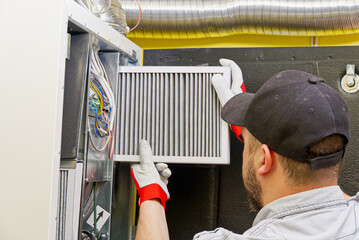A well-planned kitchen remodel can save you money in the long run. Installing energy-efficient appliances and materials, for example, will reduce your utility bills.
Kitchen remodeling usually starts with removing wall and ceiling drywall to reveal the structural framing. It may also involve moving or knocking down partition walls and building additions. Talk to the experts from Thompson & Boys LLC for your kitchen remodeling plans.
 Space
Space
If your kitchen is small, poorly laid out or outdated, it’s time to consider a renovation. Kitchen remodeling is more than just cosmetic — it can increase your home’s value, enhance functionality, and improve resale.
When your kitchen isn’t suited to how you live and cook, it can feel like a constant struggle. Fortunately, there are many ways to change that. You may want to replace your cabinetry, update the appliances, or make other changes to give your kitchen a complete overhaul. In this case, you will most likely need the help of a professional.
Once you’ve evaluated your needs and the goals you want your kitchen to accomplish, it’s a good idea to create an initial design plan for what your remodel should include. This will include your big-picture goals, style descriptions, and a list of necessary and desired items. This process will help you prioritize what needs to be done and allow you to scale back the list if necessary later on in the project.
A large kitchen renovation involves demolition and the addition of new elements. In this type of project, walls may be moved or changed, a basement or attic may be opened up and new flooring is almost always added. The layout is often reworked as well to accommodate the changes.
During this phase, it’s crucial to keep your contractor informed about any specific features you want included in the final design. Depending on the size of your kitchen, this could be anything from changing out a door to installing a backsplash. It’s important to remember that these details can add up in cost and may impact the timeline.
When the framing work is complete and the utilities are connected, drywall can be installed and the finished work begins. Cabinets, countertops, and flooring are installed in the order that they need to be done. If you are in a building with shared walls, you will also need to work around neighboring spaces. Lastly, you will need to comply with your condo/co-op/HOA’s alteration agreement, particularly if placing “wet” spaces such as a bathroom or kitchen over “dry” spaces is not allowed.
Comfort
When planning a kitchen remodel, homeowners often focus on style and aesthetics. However, a kitchen’s comfort level is also an important consideration for many families. Incorporating elements such as natural ventilation can help to improve air quality and reduce the amount of toxic fumes that are released into the home. For example, installing an updraft ventilation system or windows to optimize airflow can reduce cooking odors and help eliminate carbon monoxide and nitrogen dioxide. Additionally, incorporating renewable materials like bamboo cabinets or organic wool insulation can further enhance the home’s comfort by reducing energy costs.
Because a kitchen remodel is a significant investment, it is important to carefully examine all of the factors involved. For starters, it’s vital to understand why you want to remodel your kitchen. Having an understanding of your motivation can help to keep your focus throughout the process. Moreover, it can also help to avoid rushing the project or getting caught up in the COVID-19 pandemic.
After you have established why you want to remodel, it is helpful to take some time to evaluate your needs. For example, your current kitchen might not be positioned ideally in the house, it may be too small or too large, or it could lack an adequate connection to other rooms in the home.
Once you have identified the specifics of your needs, it is a good idea to start looking for a designer that can meet them. A great place to start is by asking friends and family for recommendations. If they have had work done recently, they may be able to provide you with some valuable insight into the experience of working with a particular sustainable designer.
Alternatively, you can conduct online research to find a local sustainable designer that meets your needs. By reviewing websites and looking at customer reviews, you can make a more informed decision when choosing a designer for your kitchen remodeling project.
While it’s important to consider all of the factors that go into a kitchen remodel, it’s equally important to remember that the process isn’t always easy. Even minor renovations can be challenging for many homeowners because of the complex issues that need to be addressed. Nevertheless, with proper planning and the assistance of a professional kitchen designer, you can make the most out of your kitchen remodel project.
Energy Efficiency
A kitchen remodel allows you to incorporate energy-efficient upgrades that reduce your home’s environmental footprint. During this phase of the project, you can switch to LED lights that use less power than traditional bulbs or a tankless water heater that conserves hot water usage. You can also add a ventilating range hood that improves your kitchen’s air quality by filtering the toxic pollutants that are released when cooking.
While some people consider kitchen renovation a cosmetic upgrade, others see it as a chance to revamp the space in a whole new way. This might involve turning a cramped galley kitchen into an open-concept layout or adding windows to optimize natural light. This type of major kitchen redo is a good option to increase your home’s value and appeal to potential buyers.
Regardless of the type of remodel you’re considering, it’s important to work with an experienced contractor to ensure a safe and efficient job. Your contractor should have a clear plan for the project, separating construction zones to limit your exposure to dust and debris. He or she should also check the rules of your building if you live in an apartment, condo, or co-op. In a city, for example, it’s generally against the rules to place “wet” spaces (like a kitchen or bathroom) above “dry” areas (like your living room).
After the cabinets are installed and any new flooring is laid, it’s time to install countertops. Depending on the material, this may be done before or after the appliances are in place. Once the countertop is ready, it’s time to install any backsplash tile or other finishing elements.
As a part of the finishing touches, you can take this opportunity to install an alarm system for your kitchen to protect it from theft. You can also install safety features like fire-resistant flooring and easy-to-reach storage for a fire extinguisher. In addition, you can choose to replace your appliances with star-rated models, which are designed to run more efficiently and lower your utility bills. This is one of the best ways to make a positive impact on the environment and save money over time.
Design
A new kitchen will have different dimensions and require a more complex layout. You’ll need to consider how the kitchen flows with adjoining rooms, and you may need to frame in a window, tear down (potentially load-bearing) walls, or add a ceiling. This is where a designer can help you navigate the complexities of a remodel. The contractor or a designer affiliated with the renovation company can provide options for materials that meet your design goals and budget.
You can also invest in smart storage solutions, which will improve your kitchen’s efficiency and appearance. For example, custom drawer organizers are an inexpensive way to increase your kitchen’s storage capacity without spending money on new cabinetry. Installing open shelving is another affordable solution that can make your kitchen appear more spacious and allow you to showcase your prettiest dishes.
Other low-cost remodeling ideas include changing the paint color on cabinets or walls or switching out the hardware to modern nickel or black finishes. You can also replace your kitchen floor with durable luxury plank vinyl in a wood look, which is both long-lasting and easy to clean. Adding a new backsplash is another simple way to update your kitchen at a low cost.
The big expense during a kitchen remodel is often demolition and construction labor. If you’re ripping down walls and drywall to expose old foundations, be sure to add a layer of insulation to prevent costly heat loss. Contractors typically recommend spray foam insulation, which offers a tight seal and superior energy efficiency, but fiberglass batt insulation is just as effective for less money.
Many homeowners choose to hire a general contractor for their kitchen remodeling project. This type of professional manages the entire renovation, including the work of subcontractors and sourcing of products. Some contractors can take on the additional role of a designer and/or architect, while others can only execute the design you’ve created.
If your kitchen remodel will be a major undertaking, prepare by setting up a temporary cooking space. This will be easier if you’re able to use your garage or a neighbor’s kitchen during the remodel, but a small refrigerator and microwave will suffice if not. You’ll also need to create a staging area where you can inspect and store each new product before it’s installed.



 Water Line
Water Line


 Most HVAC jobs are full-time, though some may have to work irregular hours in peak seasons. These positions require extensive training and a strong level of technical knowledge. HVAC technicians at
Most HVAC jobs are full-time, though some may have to work irregular hours in peak seasons. These positions require extensive training and a strong level of technical knowledge. HVAC technicians at